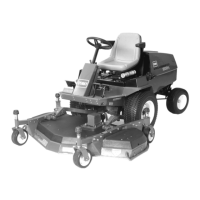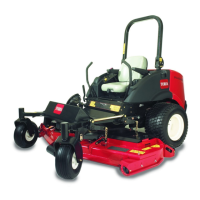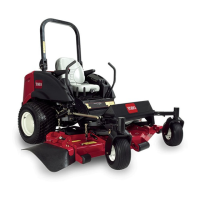27
Engine must be running so transmission neutral
adjustment can be performed. Contact with
moving parts or hot surfaces may cause personal
injury.
Keep hands, feet, face, clothing and other body
parts away from rotating parts, muffler and other
hot surfaces.
Warning
m–5179
1
2
Figure 29
1. Adjustment cam 2. Lock nut
6. Stop the engine and tighten the locknut to secure the
adjustment (Fig. 29).
7. Start the engine and check the adjustment. Repeat the
adjustment, if necessary.
8. Stop the engine. Remove the jack stands and lower the
machine to the shop floor. Test drive the machine to be
sure it does not creep.
Adjusting the Electric Clutch
The clutch is adjusted to ensure proper engagement and
braking action.
1. Disengage the power take off (PTO), set the parking
brake, stop the engine, and remove the key.
2. To adjust the clutch, tighten or loosen the locknuts on
the flange studs (Fig. 30).
3. Check the adjustment by inserting a feeler gauge
through the slots next to the studs.
4. The proper disengaged clearance between the clutch
plates is 0.012–0.018 in. (0.30–0.45 mm). It will be
necessary to check this clearance at each of the three
slots to ensure that the plates are parallel to each other.
M–4352
1
2
Figure 30
1. Locknut 2. Adjustment slot
Checking the Hydraulic System
Fluid
Hydraulic fluid escaping under pressure can
penetrate skin and cause injury.
• If hydraulic fluid is injected into the skin it must
be surgically removed within a few hours by a
doctor familiar with this type of injury.
Gangrene may result if this is not done.
• Keep body and hands away from pin hole leaks
or nozzles that eject high pressure hydraulic
fluid.
• Use cardboard or paper to find hydraulic leaks.
• Safely relieve all pressure in the hydraulic
system before performing any work on the
hydraulic system.
• Make sure all hydraulic fluid hoses and lines are
in good condition and all hydraulic connections
and fittings are tight before applying pressure to
hydraulic system.
Warning
The hydraulic system is designed to operate on SAE
10W-30 engine oil or, as a substitute, SAE 10W-40 engine
oil. The reservoir is filled at the factory with approximately
4.73l (5 U.S. quarts) of 10W-30 engine oil. Check the
reservoir oil level before the engine is first started and daily
thereafter.
1. Position the machine on a level surface and stop the
engine.

